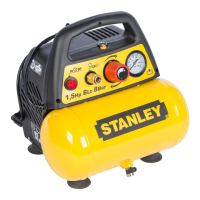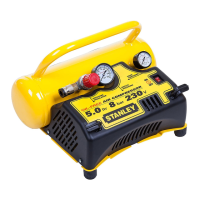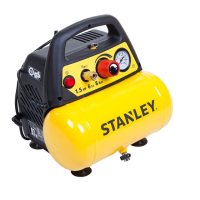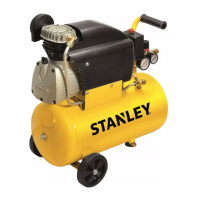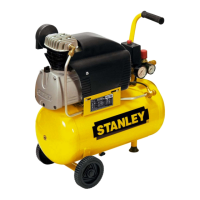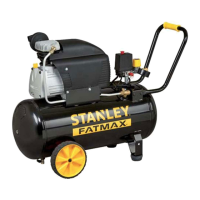G
B
15
There are no user serviceable parts inside this product
except those referred to in the manual. Always refer
servicing to qualified service personnel. Never remove
any part of the casing unless qualified to do so; this unit
containsdangerousvoltages.
Warning!
For your protection if this product is to be used outdoors it
shouldnotbeexposedtorainorusedindamplocations.Do
not place the product on damp surfaces, use a workbench
ifavailable.Foraddedprotectionuseasuitableresidual
currentdevice(R.C.D.)atthesocketoutlet.
Note: If the mains cable requires replacing it must be
replaced with an identical one and fitted by a
qualifiedperson.
5. PRE-START PROCEDURES
● Examine the machine for signs of transport damage.
Report any damage immediately to the company which
deliveredthecompressor.
● Verifythatthetankshavebeendrainedandareclearof
anymoistureordirt.
● The compressor should be set up near the working
consumer.
● Avoidlongairlinesandlongsupplylines(extensions).
● Makesuretheintakeairisdryanddust-free.
● Donotsetupthecompressorindamporwetrooms.
● The compressor mayonly be used in suitable rooms
(with good ventilation and an ambient temperature from
+5°Cto+40°C).Theremustbenodust,acids,vapours,
explosivegasesorinflammablegasesintheroom.
● Thecompressorisdesignedtobeusedindryrooms.It
is prohibited to use the compressor in areas where work
isconductedwithsprayedwater.
6. OPERATION INSTRUCTIONS
6.1 Start-Up Procedures
1. VerifythattheOn/OffswitchisintheOffposition.
2. Verifythatthetankairpressureisat0PSI.
3. Attachtheairhosetothedischargeline.
4. Plugtheunitintoaproperlygroundedoutlet.
5. Push the On/Off switch to On. The On/Off switch
will light-up to indicate the compressor is on. The
compressor will automatically cycle on and off to keep
thetankpressuremaintained.
6. Adjust the pressure regulator to the proper pressure
settingrequiredfortheairtool.
6.2 Shut-Off Procedures
1. PushintheOn/OffswitchtotheOffposition.
7. CLEANING AND MAINTENANCE
Warning!
Pull the power plug before doing any cleaning and
maintenance work on the appliance.
Warning!
Wait until the compressor has completely cooled
down. Risk of burns!
Warning!
Always depressurize the tank before carrying out any
cleaning and maintenance work.
7.1 Cleaning
● Keep the safety devices free of dirt and dust as far
aspossible.Wipetheequipmentwithacleanclothor
blowitwithcompressedairatlowpressure.
● We recommend that you clean the appliance
immediatelyafteryouuseit.
● Clean the appliance regularly with a damp cloth
and some soft soap. Do not use cleaning agents or
solvents; these may be aggressive to the plastic parts
intheappliance.Ensurethatnowatercangetintothe
interioroftheappliance.
● Youmustdisconnectthehoseandanysprayingtools
fromthecompressorbeforecleaning.Donotcleanthe
compressorwithwater,solventsorthelike.
7.2 Draining tank
The condensation water must be drained off each day
byopeningthedrainvalve(ref.E)(onthebottomofthe
pressurevessel).
1. VerifythatthecompressoristurnedOff.
2. Holding the handle, tilt the compressor toward the
drain valve so that they are positioned at the bottom of
thetank.
3. Turnthedrainvalvetoopenthevalve.
4. Keepthecompressortilteduntilallmoisturehasbeen
removed.
Warning!
The condensation water from the pressure vessel
will contain residual oil. Dispose of the condensation
water in an environmentally compatible manner at the
appropriate collection point.
7.3 Safety valve (ref. G)
The safety valve has been set for the highest permitted
pressureofthepressurevessel.Itisprohibitedtoadjust
thesafetyvalveorremoveitsseal.Actuatethesafetyvalve
fromtimetotimetoensurethatitworkswhenrequired.
Pulltheringwithsufficientforce(fig.8)untilyoucanhear
thecompressedairbeingreleased.Thenreleasethering
again.
7.4 Storage
Warning!
Pull the mains plug out of the socket and ventilate the
appliance and all connected pneumatic tools.
Switch off the compressor and make sure that it is
secured in such a way that it cannot be started up

